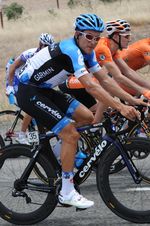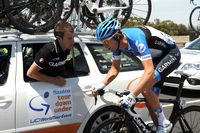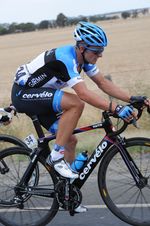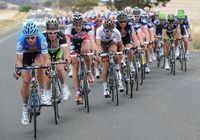5 Tips to Start the Season Like a Pro
2. Exercise Testing
In order to start training correctly, we all need to know what our fit status is. This doesn’t mean knowing whether we are in good, bad, or fair shape. It means we need to understand how our body responds to a given workload. Doing an exercise test provides us with necessary information so that we can  train in the correct zones. This is very important because different training zones require different fuel and train different systems (aerobic or anaerobic). At this point in the year you want to be establishing an aerobic base, so knowing exactly what training zones to use when doing this is the first step. Most exercise tests involve an incremental (step-wise increase in load) exercise test for a given duration. These tests are done in a laboratory and generally involve using tools such as a lactate analyzer to measure how much blood lactate you produce during each step. Not everyone has access to an exercise laboratory to do this, so field tests are a good way to get a reliable measure of your current fitness status and provide a means of estimating your heart rate zones. If you have a stop watch, heart rate monitor and/or power meter you can do a field test. Knowing the results from such a test will allow you to start building an aerobic base. Following is an example of a field test you can try at home:
train in the correct zones. This is very important because different training zones require different fuel and train different systems (aerobic or anaerobic). At this point in the year you want to be establishing an aerobic base, so knowing exactly what training zones to use when doing this is the first step. Most exercise tests involve an incremental (step-wise increase in load) exercise test for a given duration. These tests are done in a laboratory and generally involve using tools such as a lactate analyzer to measure how much blood lactate you produce during each step. Not everyone has access to an exercise laboratory to do this, so field tests are a good way to get a reliable measure of your current fitness status and provide a means of estimating your heart rate zones. If you have a stop watch, heart rate monitor and/or power meter you can do a field test. Knowing the results from such a test will allow you to start building an aerobic base. Following is an example of a field test you can try at home:
-Warm up for 15 – 20 minutes. Do a few short sprint efforts to prepare for the test.
-Do a 30-minute Time Trial effort (this means go as hard as you can). This effort should be done on consistent terrain (preferably flat) or an indoor trainer. Ten minutes into the test, press the record button on your Garmin. You will need your heart rate monitor. You are trying to ca pture your average power and heart rate for the last 20 minutes of the test. This average is an estimate of your lactate threshold. Make sure to finish the TT effort giving it everything you have.
pture your average power and heart rate for the last 20 minutes of the test. This average is an estimate of your lactate threshold. Make sure to finish the TT effort giving it everything you have.
– Cool down for 15 – 20 minutes. Try to continue pedaling at a high cadence but low intensity.
3. Aerobic Base Training
At this time in the year a lot of cyclists start building on what they call “base miles.” Generally, these miles are slow and at a low intensity. While these slow rides don’t seem like they contain a lot of quality, they are actually the most important rides you will do all year. Whether you are on an indoor trainer or riding the snow, spending time riding at a low intensity (65-75% lactate threshold) will provide the foundation for the rest of your season. For beginners, start with 2-3 times per week for 45 minutes and continue to build on the duration. If you are a more experienced cyclist, you may be able to train for 7 – 1 2 hours per week at this intensity. Remember, no matter what level you are at, the goal is to build on your current aerobic fitness by increasing the time you spend training at this intensity. You are training your body to burn fat for fuel, building on your cardiovascular fitness, and strengthening your joints for the much higher intensity workouts you will do later in the year.
2 hours per week at this intensity. Remember, no matter what level you are at, the goal is to build on your current aerobic fitness by increasing the time you spend training at this intensity. You are training your body to burn fat for fuel, building on your cardiovascular fitness, and strengthening your joints for the much higher intensity workouts you will do later in the year.
4. Strength Training on the Bike
During the off season it is important to do strength training. This can be accomplished in your gym with weights, or more specifically applied to cycling while on your bike. While doing low intensity base miles, it is important to include 1-2 sessions per week of low cadence ( 75-80rpm ) intervals of about 5 minutes in duration. These intervals should be done at the start of your workout and you only want to do 1-2 throughout to avoid excess stress to your knees and hips. These intervals will help build muscular strength that will provide a foundation for more intense intervals later in the season.
5. Goal Setting 
Each professional athlete sits down at the beginning of the year to talk about what his or her performance goals are for the season. Whether it to help a teammate win Paris-Roubaix, win the Tour de France, or gain better fitness, having these goals written down is important to motivating us throughout the year. At any level, it is important to set 3-5 goals for the upcoming season. These goals should be challenging but realistic and achievable. Remember to make them personal and something that you will want to work toward. Everyone has fitness goals, and setting them will help you stay motivated and feel rewarded as you achieve them.
Take a look at Martijn Maaskant’s Edge 800 data from Stage One and if you are looking for more tips from the pros and that extra motivation, head over to our Winter Training corner!!
The post 5 Tips to Start the Season Like a Pro appeared first on Garmin Blog.
Sample Block Quote
Praesent vestibulum congue tellus at fringilla. Curabitur vitae semper sem, eu convallis est. Cras felis nunc commodo loremous convallis vitae interdum non nisl. Maecenas ac est sit amet augue pharetra convallis nec danos.
Sample Paragraph Text
Praesent vestibulum congue tellus at fringilla. Curabitur vitae semper sem, eu convallis est. Cras felis nunc commodo eu convallis vitae interdum non nisl. Maecenas ac est sit amet augue pharetra convallis nec danos dui.
Cras suscipit quam et turpis eleifend vitae malesuada magna congue. Damus id ullamcorper neque. Sed vitae mi a mi pretium aliquet ac sed elitos. Pellentesque nulla eros accumsan quis justo at tincidunt lobortis denimes loremous. Suspendisse vestibulum lectus in lectus volutpat, ut dapibus purus pulvinar. Vestibulum sit amet auctor ipsum.

